Summer is here with its bright sunshine and warm weather, making it the perfect time to plant and enjoy the beauty of flowers. Pay attention to regular care of your flowers, choose good soil, water well and add fertilizer to keep them blooming and showing their colors until the end of summer. Here is a list of ideal flowers to plant in summer, bringing life and freshness to your garden.
Best summer flowers for a lush and colorful garden
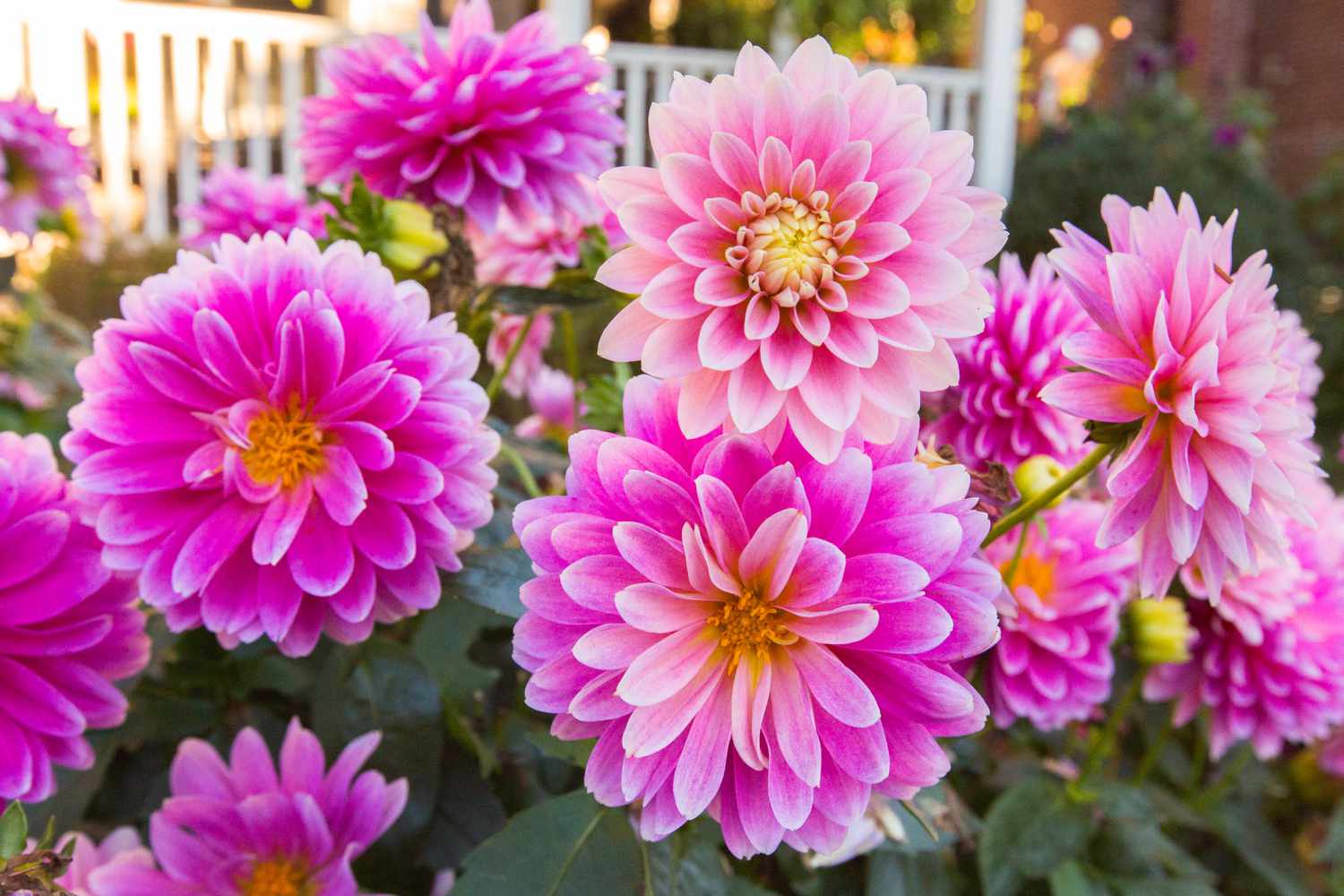
Summer is a glorious season characterized by long days, warm temperatures, and vibrant blooms. The right flowers can transform your outdoor space into a colorful paradise, creating a joyful atmosphere for relaxation and entertainment. Whether you’re a seasoned gardener or a beginner, knowing which flowers thrive in the summer heat is essential for a thriving garden. This guide will explore some of the best summer flowers, detailing their characteristics, benefits, and care tips to help you cultivate a stunning garden.
Sunflower
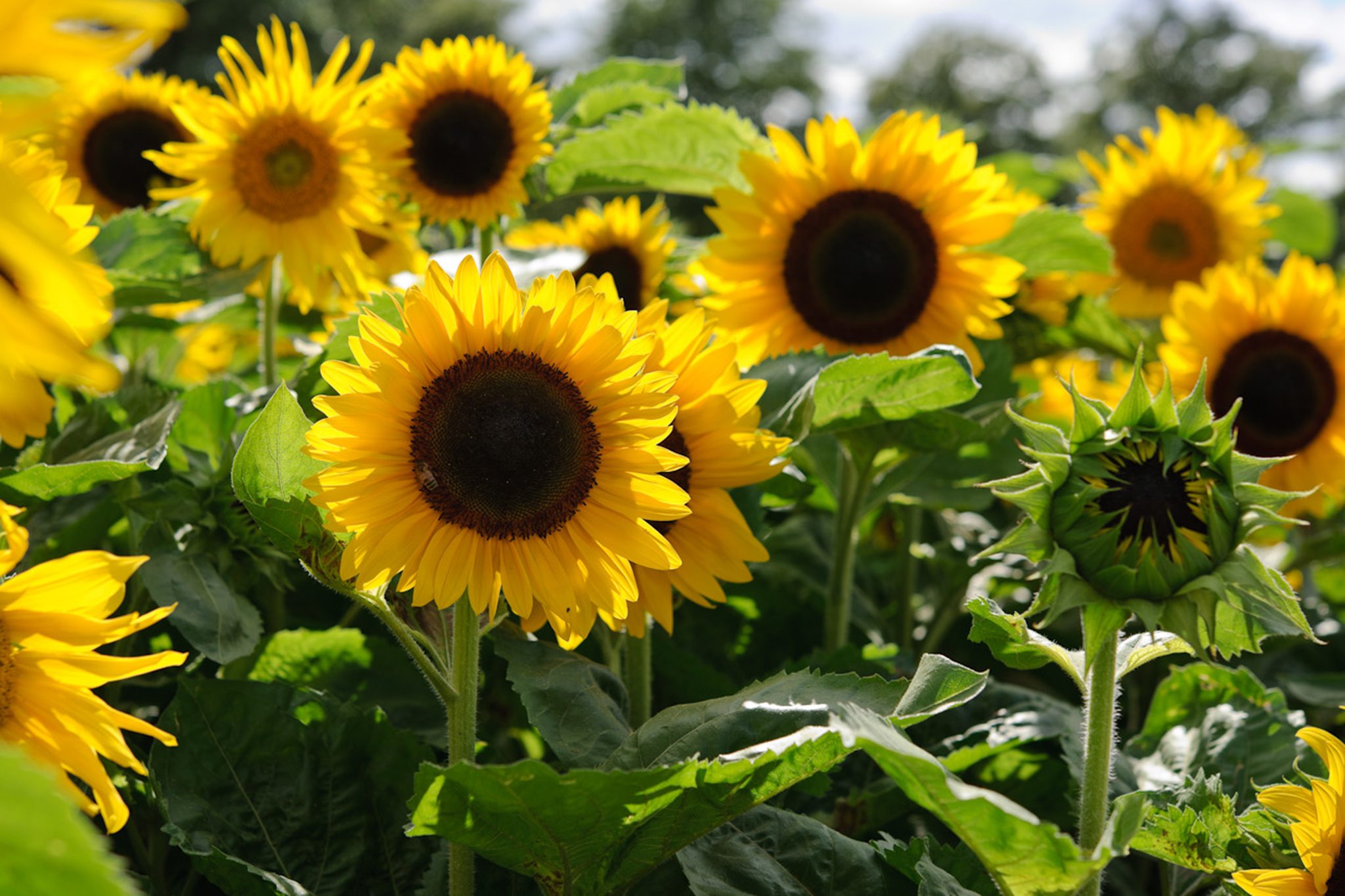
Description
Sunflowers (Helianthus annuus) are iconic summer flowers that can grow tall and majestic, reaching heights of up to 10 feet. Their large, vibrant yellow petals and dark centers are instantly recognizable and evoke feelings of warmth and happiness. Sunflowers are not just beautiful; they also turn their heads to follow the sun, a phenomenon known as heliotropism.
Benefits
- Pollinator attraction: Sunflowers attract a variety of pollinators, including bees and butterflies, making them essential for a healthy garden ecosystem.
- Edible seeds: The seeds produced by sunflowers are nutritious and can be harvested for snacks, bird feeders, or even pressed into oil.
- Easy to grow: They are straightforward to plant and care for, making them ideal for beginner gardeners.
Care Tips
- Planting time: Sow seeds directly into the soil after the last frost in spring, typically in late April to early May.
- Sunlight: Sunflowers thrive in full sun, requiring at least 6-8 hours of sunlight daily.
- Soil requirements: Well-draining soil is essential; they prefer slightly acidic to neutral pH.
- Watering: Water regularly, especially during dry spells, but avoid overwatering, as this can lead to root rot.
- Fertilization: A balanced fertilizer can be applied at planting time to promote strong growth.
Zinnia
Description
Zinnias (Zinnia elegans) are vibrant annuals renowned for their colorful blooms and long-lasting flowers. They come in a variety of shapes and sizes, from the classic round blooms to more unique petal structures. Zinnias are available in numerous colors, including pink, red, orange, and yellow, making them perfect for adding brightness to any garden.
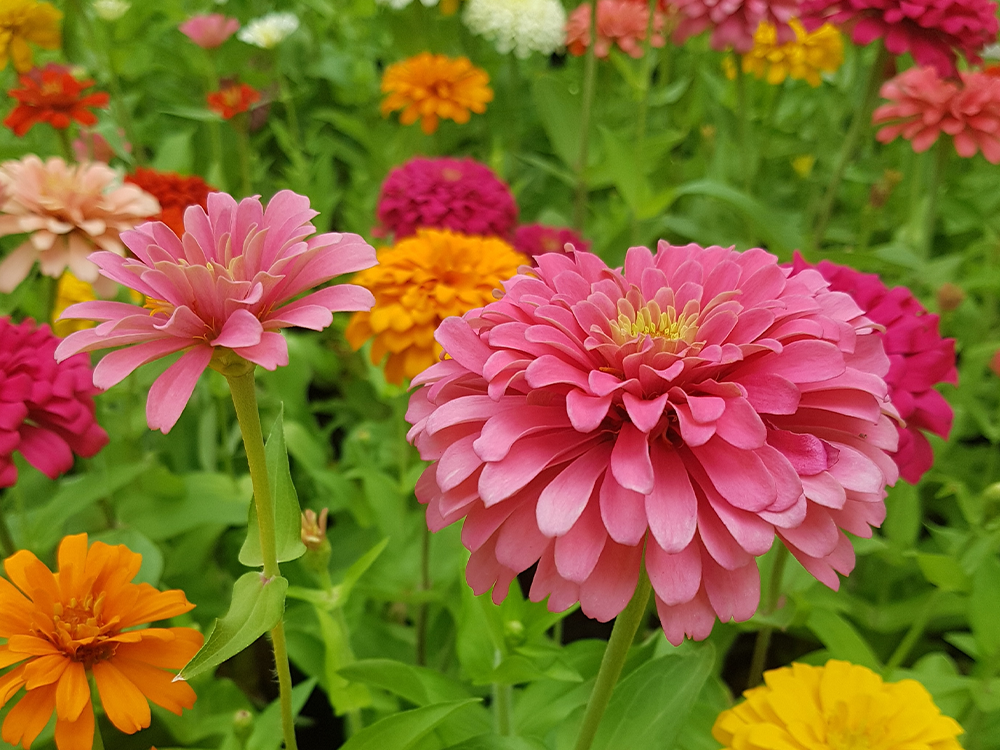
Benefits
- Low maintenance: Zinnias are drought-tolerant and require minimal care, making them perfect for busy gardeners.
- Attracts pollinators: These flowers are a favorite among butterflies, making them ideal for a pollinator-friendly garden.
- Versatile Use: Great for borders, garden beds, or as cut flowers for arrangements.
Care tips
- Planting time: Sow seeds directly into the soil after the last frost, usually in late spring.
- Sunlight: Zinnias love full sun and need at least 6-8 hours of sunlight each day.
- Soil requirements: They thrive in well-drained soil and can tolerate poorer soil conditions.
- Watering: Water regularly, allowing the soil to dry slightly between waterings.
- Deadheading: Regularly removing spent blooms encourages more flowering.
Dahlia
Description
Dahlias (Dahlia spp.) are beloved for their stunning and intricate blooms that come in various shapes, sizes, and colors. From small pom-pom dahlias to large dinner plate varieties, these flowers can create a dramatic focal point in any garden.
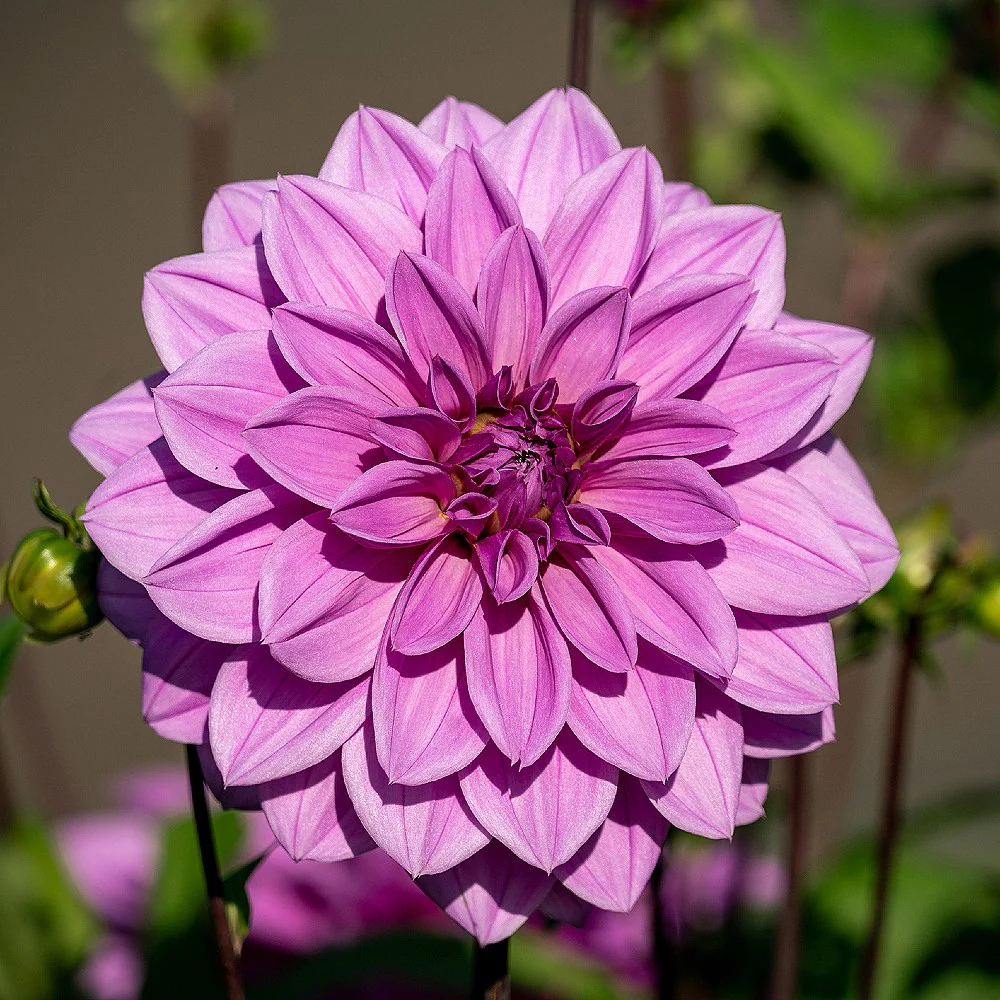
Benefits
- Long blooming season: Dahlias bloom from mid-summer until the first frost, providing color for months.
- Variety: With hundreds of cultivars available, you can easily find dahlias that suit your style and garden theme.
- Cut flower quality: They are excellent for floral arrangements due to their long-lasting blooms and striking appearance.
Care tips
- Planting time: Plant tubers in spring after the danger of frost has passed, usually in late April to May.
- Sunlight: Dahlias prefer full sun, needing at least 6-8 hours of sunlight daily.
- Soil requirements: They thrive in well-draining soil rich in organic matter.
- Watering: Keep the soil consistently moist but avoid waterlogging, as this can damage the tubers.
- Fertilization: Use a balanced fertilizer every few weeks to encourage robust growth and flowering.
Cosmos
Description
Cosmos (Cosmos bipinnatus) are delicate, daisy-like flowers that add a touch of whimsy to summer gardens. They come in various colors, including pink, white, and orange, and can reach heights of up to 4 feet. Their feathery foliage adds texture to the garden.

Benefits
- Easy to grow: Cosmos are low-maintenance and can thrive in poor soil conditions, making them ideal for new gardeners.
- Attracts butterflies: These flowers are known to attract butterflies, making them perfect for wildlife gardens.
- Long blooming season: They bloom continuously from summer to fall, providing ongoing color in the garden.
Care Tips
- Planting time: Sow seeds directly in the garden after the last frost, usually in late spring.
- Sunlight: Cosmos prefer full sun and can tolerate some light shade.
- Soil requirements: They thrive in well-draining soil but can adapt to poorer soils.
- Watering: Water regularly, allowing the soil to dry out between waterings.
- Deadheading: Remove spent blooms to encourage more flowering.
Marigold
Description
Marigolds (Tagetes spp.) are vibrant annual flowers known for their bright orange and yellow hues. These hardy flowers are often used in garden beds and borders, providing a cheerful splash of color.
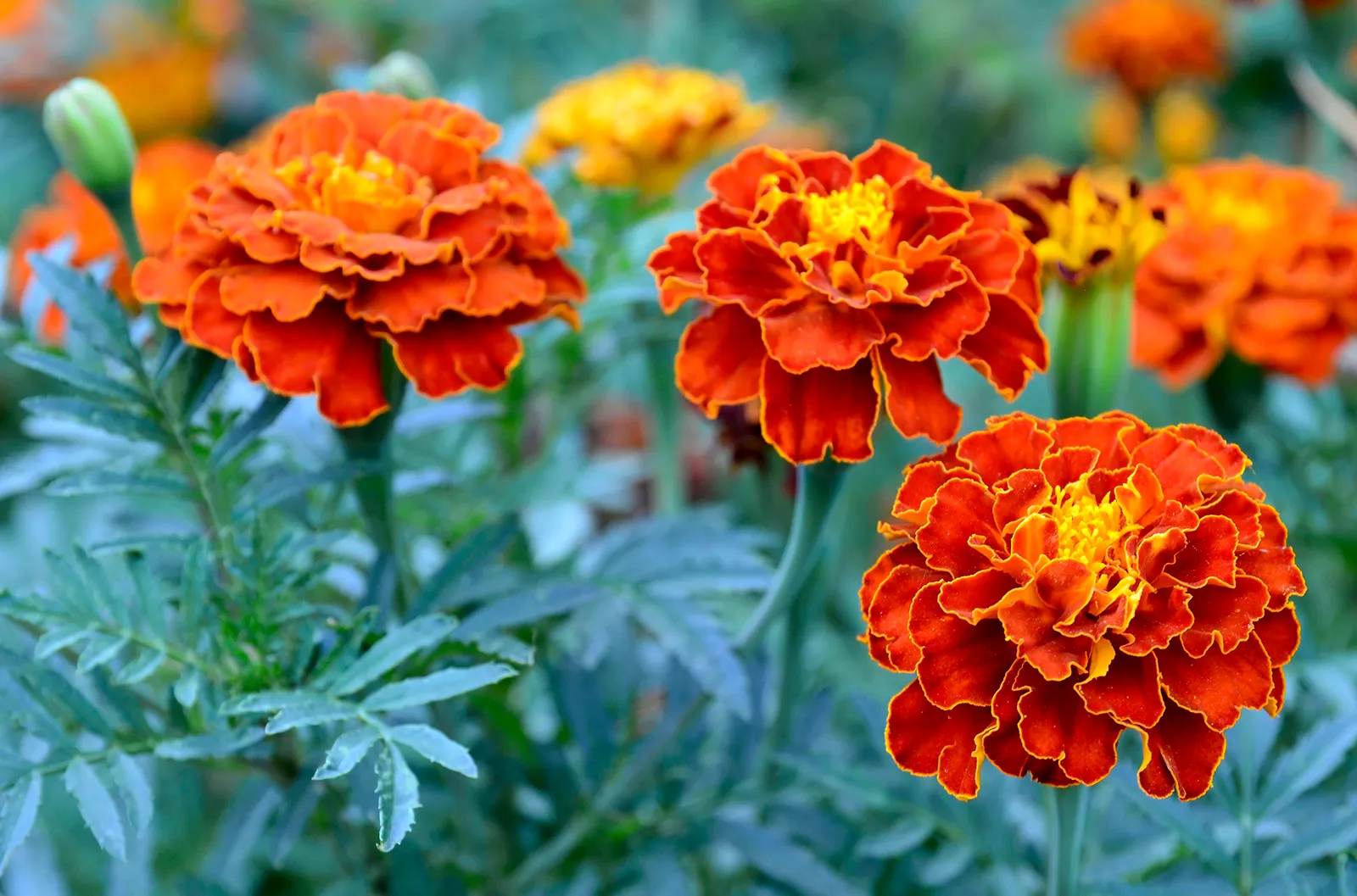
Benefits
- Pest deterrent: Marigolds are known to repel pests like nematodes and aphids, making them beneficial companions for vegetable gardens.
- Easy to grow: They are low-maintenance and can tolerate a range of soil conditions.
- Long-lasting blooms: Marigolds bloom continuously throughout the summer, providing ongoing color.
Care tips
- Planting Time: Sow seeds directly in the garden after the last frost or start indoors a few weeks earlier.
- Sunlight: Marigolds thrive in full sun, requiring at least 6 hours of sunlight daily.
- Soil requirements: They prefer well-draining soil and can tolerate poor soils.
- Watering: Water regularly, allowing the soil to dry slightly between waterings.
- Fertilization: A balanced fertilizer can help enhance growth, especially in nutrient-poor soils.
Coneflower (echinacea)
Description
Coneflowers (Echinacea purpurea) are hardy perennials known for their daisy-like appearance and distinct cone-shaped centers. They are available in a range of colors, including pink, purple, and white, and can reach heights of 3-4 feet.
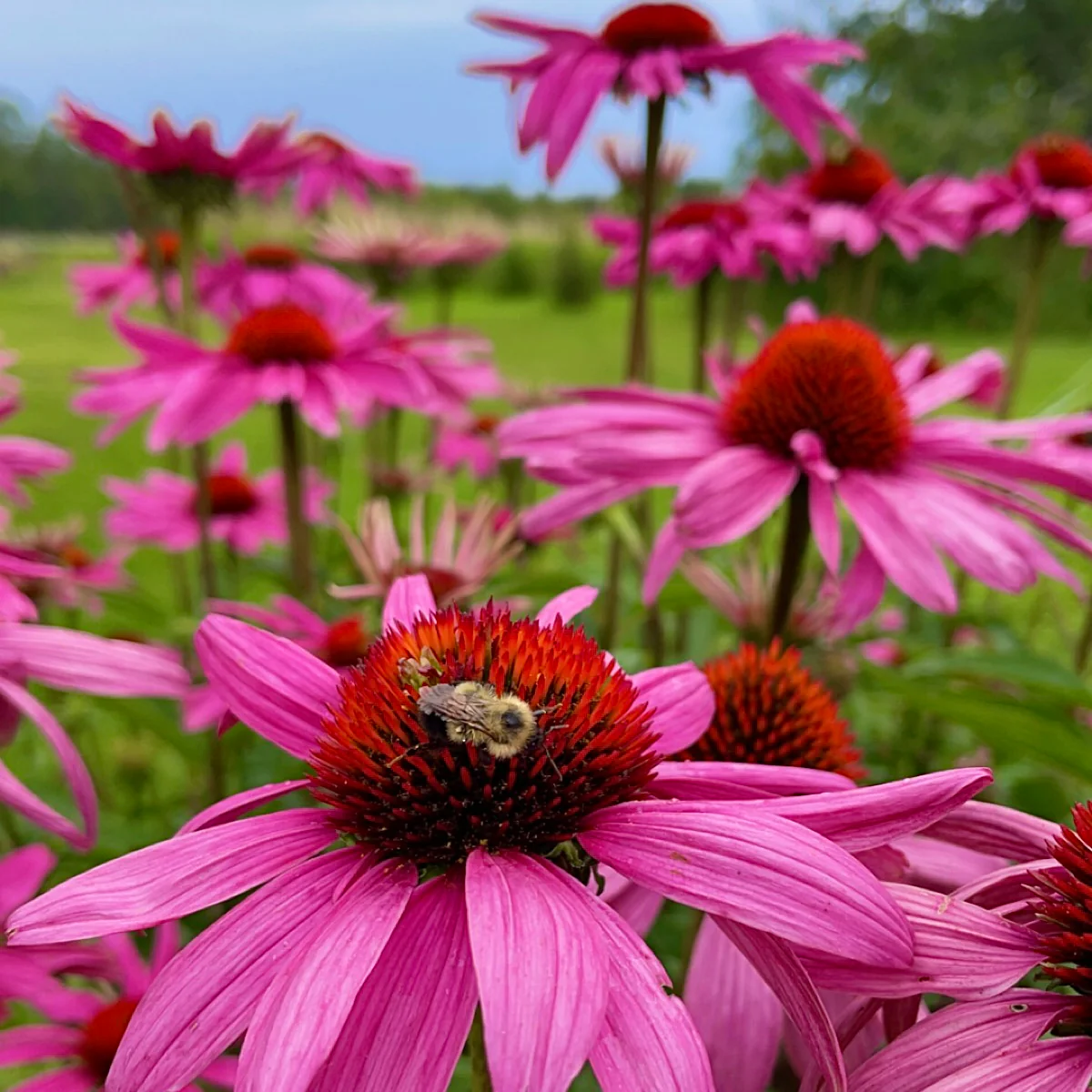
Benefits
- Pollinator friendly: Coneflowers attract bees and butterflies, supporting local wildlife and enhancing your garden’s ecosystem.
- Drought tolerance: Once established, they can tolerate dry conditions, making them suitable for xeriscaping.
- Medicinal properties: Echinacea is known for its immune-boosting properties and is often used in herbal remedies.
Care Tips
- Planting time: Plant in spring or early fall.
- Sunlight: They prefer full sun but can tolerate partial shade.
- Soil requirements: Well-draining soil with moderate fertility is best for healthy growth.
- Watering: Water regularly, especially during dry spells, but allow the soil to dry out between waterings.
- Fertilization: A light application of fertilizer in the spring can help promote blooming.
Petunia

Description
Petunias (Petunia spp.) are versatile annuals known for their vibrant colors and ability to bloom throughout the summer. They come in various colors and patterns, making them popular choices for containers, hanging baskets, and garden beds.
Benefits
- Continuous blooms: Petunias bloom from spring until frost, providing ongoing color in your garden.
- Wide color range: Available in many colors and patterns, petunias can complement any garden style or theme.
- Low maintenance: Petunias are easy to care for and can thrive in many conditions.
Care Tips
- Planting time: Plant after the last frost in spring, usually in late April or May.
- Sunlight: They thrive in full sun but can tolerate partial shade.
- Soil requirements: Well-draining soil is essential for healthy growth.
- Watering: Keep the soil moist, allowing it to dry slightly between waterings, especially in containers.
- Fertilization: Use a balanced fertilizer every few weeks to encourage vigorous growth.
Black-eyed susan
Description
Black-eyed Susans (Rudbeckia hirta) are perennial flowers known for their bright yellow petals and dark brown centers. These cheerful flowers can grow to be about 2-3 feet tall and are commonly found in wildflower gardens.
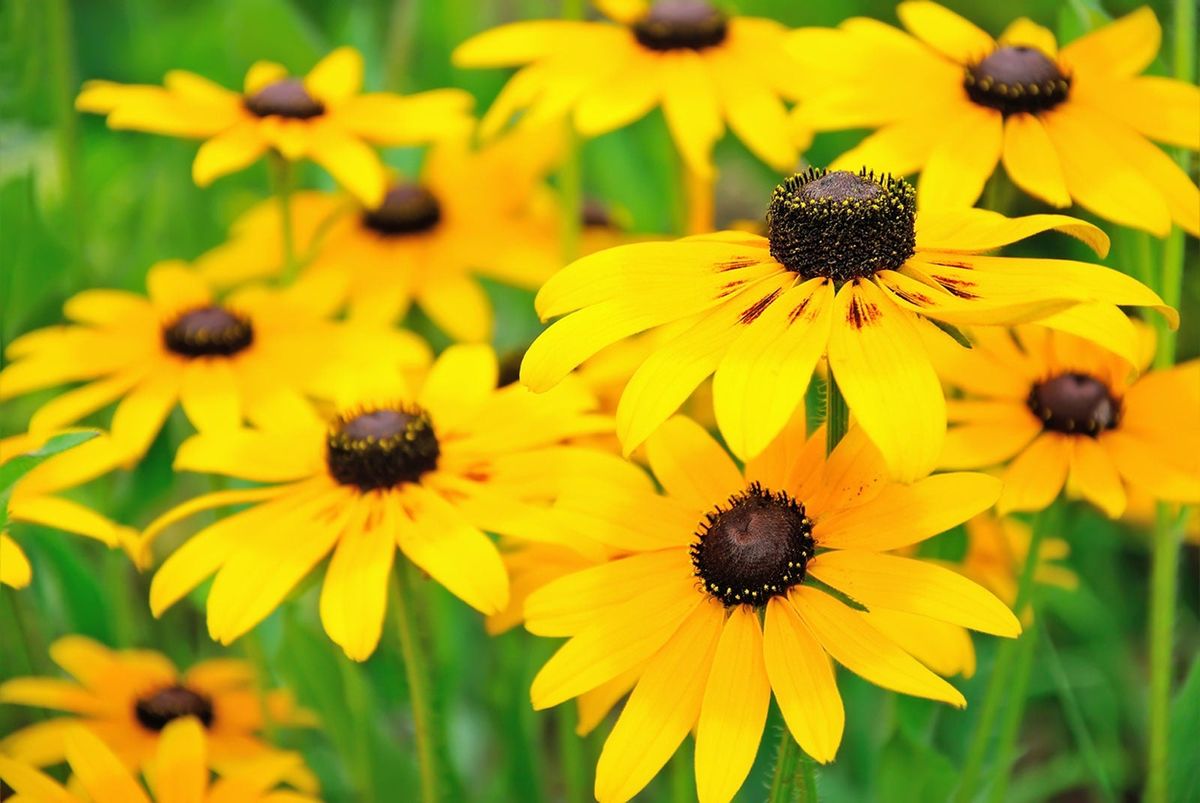
Benefits
- Pollinator magnet: These flowers attract bees and butterflies, promoting biodiversity in your garden.
- Long blooming season: They bloom from summer into fall, providing color for months.
- Low maintenance: Once established, black-eyed Susans require little care and can tolerate drought.
Care Tips
- Planting time: Plant in spring or early fall.
- Sunlight: They prefer full sun but can tolerate light shade.
- Soil requirements: They thrive in well-drained, average soil.
- Watering: Water regularly until established; they are drought-tolerant once mature.
- Fertilization: Fertilize sparingly; too much nitrogen can lead to fewer flowers.
Geranium
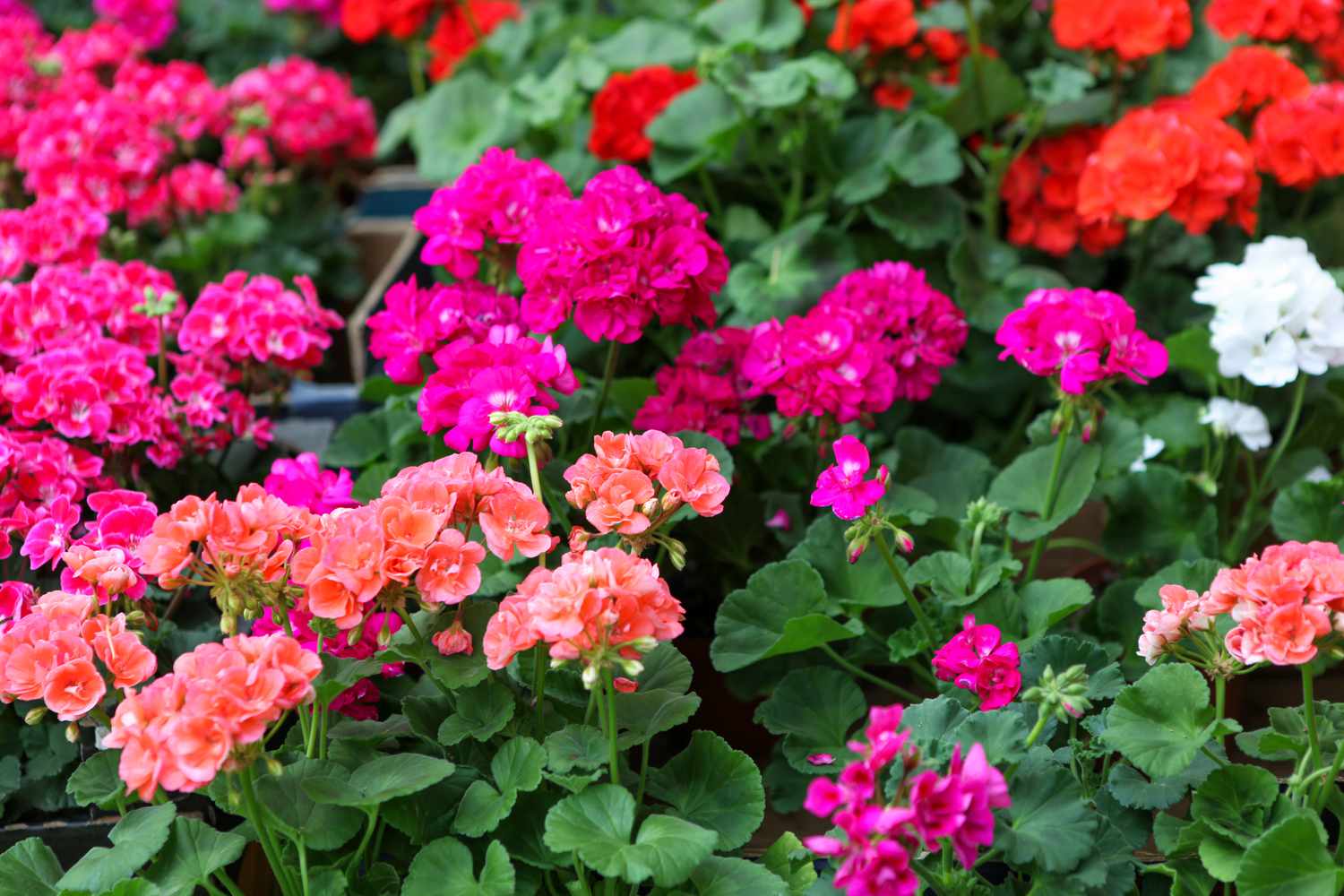
Description
Geraniums (Pelargonium spp.) are popular garden plants with vibrant blooms and fragrant leaves. Available in many colors, including red, pink, white, and purple, geraniums are perfect for adding charm to any garden.
Benefits
- Long-lasting blooms: Geraniums can bloom continuously throughout the summer, providing vibrant color.
- Fragrant foliage: The leaves have a pleasant scent, adding an aromatic element to the garden.
- Versatility: Suitable for garden beds, containers, and window boxes.
Care Tips
- Planting time: Plant after the last frost in spring.
- Sunlight: Geraniums prefer full sun but can tolerate partial shade.
- Soil requirements: They thrive in well-draining potting soil or garden soil.
- Watering: Water regularly, allowing the soil to dry slightly between waterings.
- Fertilization: Apply a balanced fertilizer every 4-6 weeks during the growing season.
Salvia
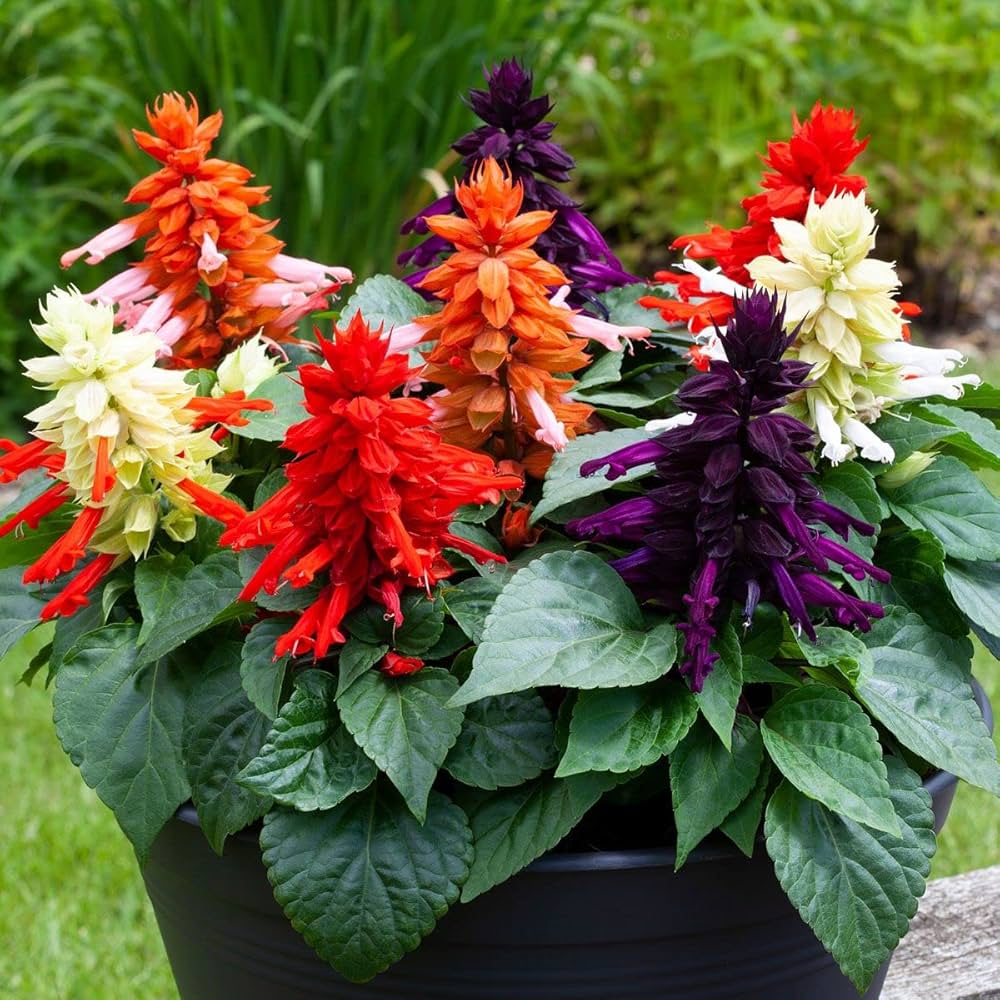
Description
Salvia (Salvia spp.) is a diverse genus of flowering plants known for their tall spikes of colorful flowers. Available in shades of blue, purple, red, and white, salvia can add height and drama to your garden.
Benefits
- Drought resistant: Once established, salvia can tolerate dry conditions, making it suitable for low-water gardens.
- Long blooming season: These flowers can bloom from early summer to fall, providing continuous color.
- Attracts pollinators: Salvia is a favorite among bees and hummingbirds.
Care Tips
- Planting time: Plant in spring or early fall.
- Sunlight: Salvia prefers full sun and thrives in well-drained soil.
- Watering: Water regularly, but allow the soil to dry out between waterings.
- Fertilization: A balanced fertilizer can be applied at planting time to promote strong growth.
Lantana
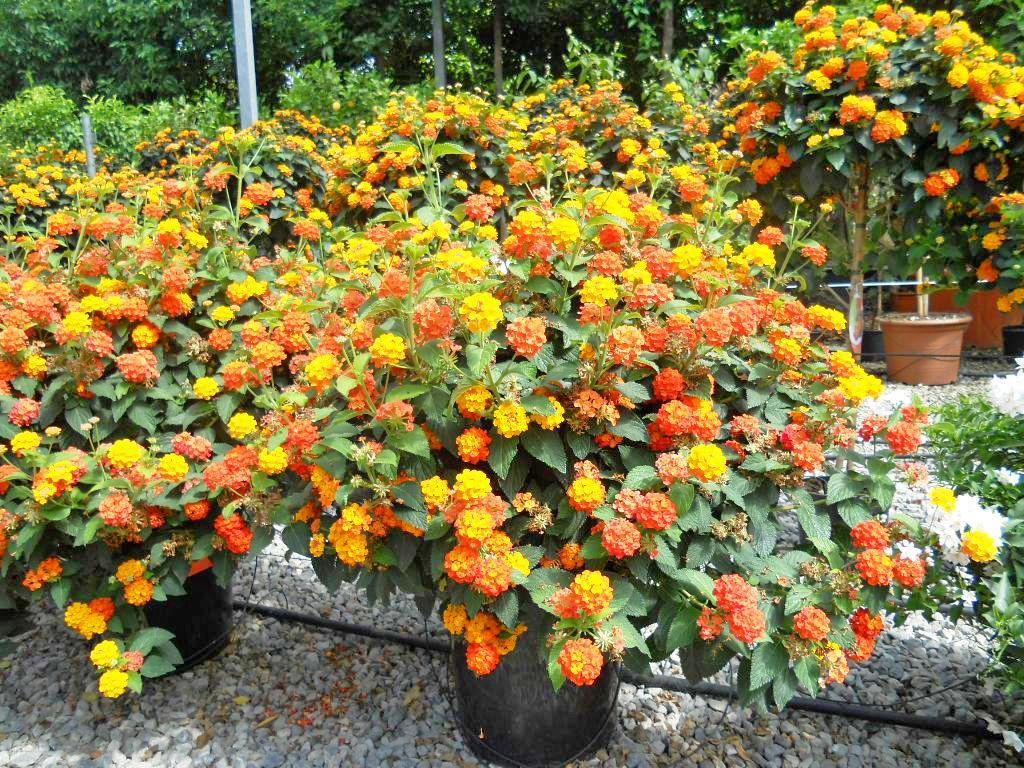
Description
Lantanas (Lantana camara) are heat-loving perennials known for their clusters of small, colorful flowers that attract butterflies and hummingbirds. They are often used in borders, containers, and hanging baskets.
Benefits
- Drought tolerance: Lantanas are highly drought-resistant once established.
- Long blooming season: These flowers bloom from spring until frost, providing continuous color.
- Low maintenance: Lantanas are easy to care for and thrive in hot, sunny conditions.
Care Tips
- Planting time: Plant after the last frost in spring.
- Sunlight: They require full sun for optimal growth.
- Soil requirements: Well-draining soil is essential.
- Watering: Water regularly, allowing the soil to dry out between waterings.
Begonia
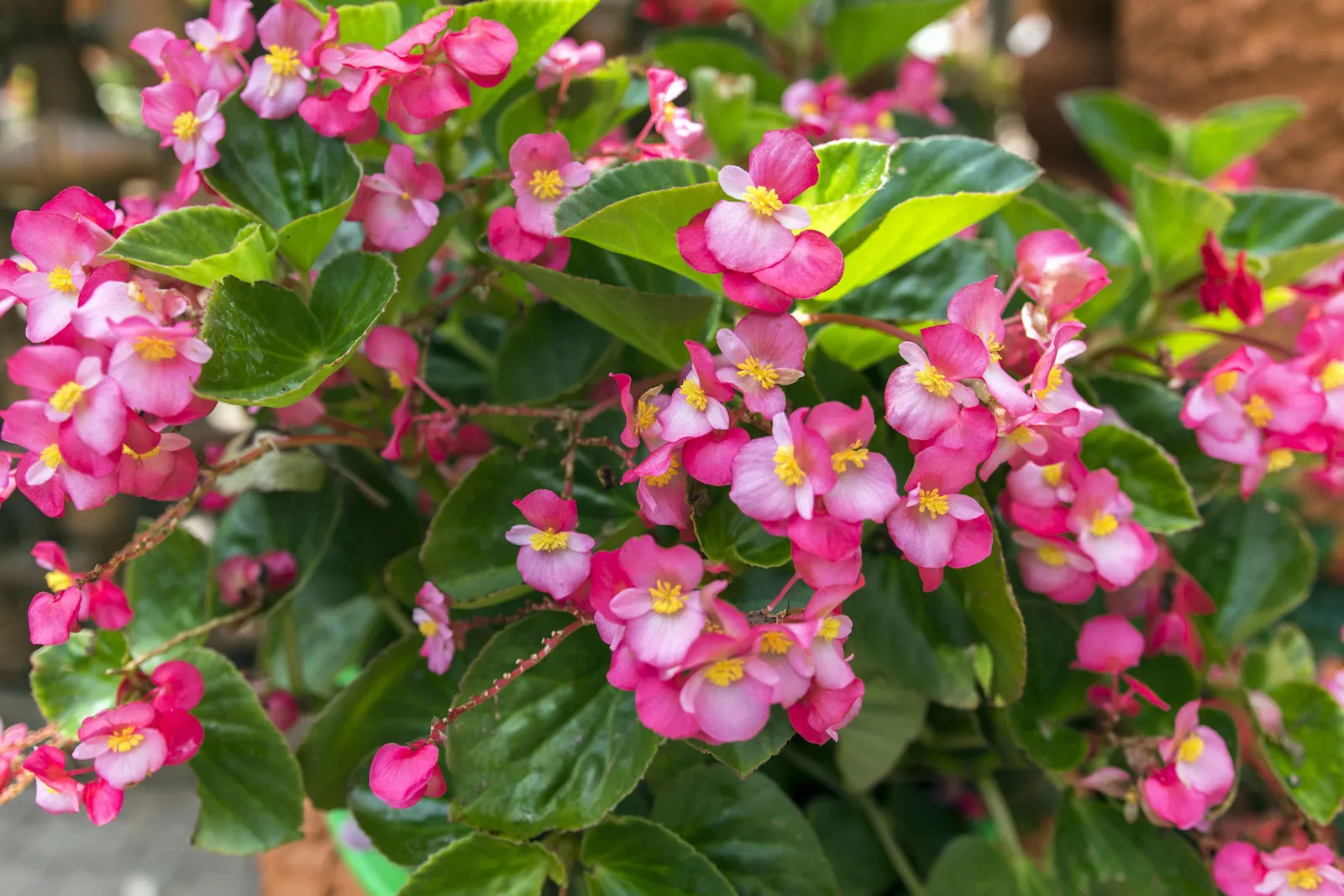
Description
Begonias (Begonia spp.) are known for their stunning foliage and colorful blooms, making them popular for both indoor and outdoor gardens. They come in various shapes, sizes, and colors, providing versatility in garden design.
Benefits
- Shade tolerance: Many begonia varieties thrive in shady conditions, making them suitable for darker areas.
- Long blooming season: Begonias can bloom continuously throughout the summer.
- Variety: They are available in numerous types, including tuberous, fibrous, and wax begonias.
Care tips
- Planting time: Plant after the danger of frost has passed.
- Sunlight: Depending on the variety, begonias can prefer full sun to partial shade.
- Soil requirements: Well-draining potting mix or garden soil is ideal.
- Watering: Keep the soil consistently moist, avoiding waterlogging.
Hydrangea

Description
Hydrangeas (Hydrangea spp.) are known for their large, showy blooms that can change color based on soil pH. These shrubs can provide stunning color and texture to any garden, making them a favorite among gardeners.
Benefits
- Long blooming season: Hydrangeas bloom from summer to fall, providing color for months.
- Variety: With many species and cultivars available, you can choose hydrangeas that fit your garden style.
- Low maintenance: Once established, they require minimal care.
Care tips
- Planting time: Plant in spring or early fall.
- Sunlight: They prefer partial shade to full sun, depending on the variety.
- Soil requirements: Well-draining, organic-rich soil is ideal.
- Watering: Hydrangeas prefer consistently moist soil, especially during dry spells.
Conclusion – Best summer flowers
Choosing the best summer flowers for your garden can create a stunning and vibrant outdoor space. Each flower on this list offers unique benefits, from attracting pollinators to providing continuous blooms throughout the season. By carefully selecting a variety of summer flowers, you can ensure a colorful display that enhances your garden’s beauty and supports local wildlife.

Related articles
Top 5 Spring Tree Pests: Identifying and Managing Common Threats
How to Grow Virginia Creeper: A Complete Guide
How to care for cyclamen from the expert
Detailed instructions: How to care for propagated plants
Understanding tree diseases: Identification, prevention, and treatment
Detailed instructions: How to care for fruit trees
Detailed instructions how to grow winter vegetables
How to propagate an aloe plant: a detailed guide to the methods